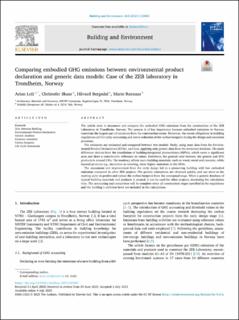| dc.description.abstract | The article aims to document and compare the embodied GHG emissions from the construction of the ZEB Laboratory in Trondheim, Norway. The process is of key importance because embodied emissions in Norway constitute the largest part of emissions from the construction sector. Moreover, the recent obligations in building regulations call for early accounting and active reduction of the carbon footprint during the design and execution processes.
The emissions are estimated and compared between two models: firstly, using most data from the Environmental Product Declarations (EPDs), and then, applying only generic data from the ecoinvent database. The main difference derives from the installation of building-integrated photovoltaics (BIPVs), which cover a significant area and show a considerable difference in values. Elsewhere, the general ratio between the generic and EPD products is around 15%. The tendency affects main building materials, such as wood, metal and concrete, while layered products e.g., insulation or covering, show higher emissions in the EPDs.
The assessment and improvement from the early design led to a pioneering building with low embodied emissions compared to other ZEB projects. The generic estimations are obtained quickly and can serve as the starting point to predict and reduce the carbon footprint from the conceptual stage. When a generic database of typical building materials and products is created, it can be used for other projects, shortening the calculation time. The accounting and comparison will be complete when all construction stages specified in the regulations and the building's ambition level are included in the calculations. | en_US |

